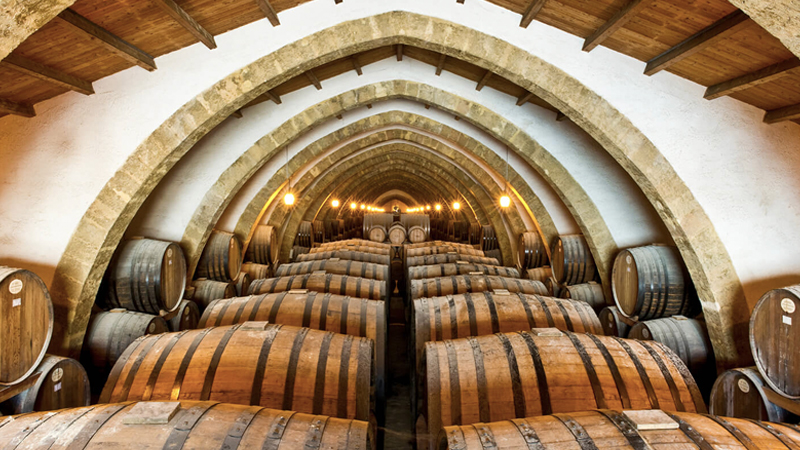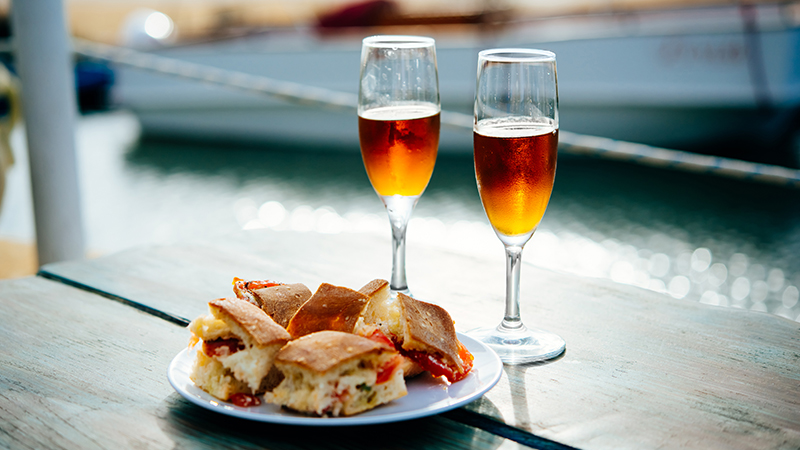The enduring ubiquity of the Italian-American dish chicken Marsala ensures that, for many Americans, Marsala is a household name. It also means that Marsala is often categorically relegated to the ranks of cooking wine — an unfair station to occupy in perpetuity for something as unique, versatile, and delicious as Marsala.
Marsala is a fortified wine named for its village of origin on the west coast of Sicily, made from a variety of native grapes and subject to oxidative aging techniques. “Among Sicilian wines, Marsala is certainly one representing the long history and traditions of the island,” says Roberto Magnisi, winery director for Cantine Florio, one of the oldest Marsala wineries in the region. Marsala was established as a denominazione di origine controllata (DOC) in 1969, codifying its singular nature and guaranteeing its quality. (Be dubious of U.S. grocery store cooking wines labeled Marsala, which bear no resemblance to the real thing.) Due to its coastal influence and Mediterranean climate, “the vineyards feed on the sea,” says Magnisi. “So much so that we can speak of an agro-marine character in the wines.”

Don’t Miss A Drop
Get the latest in beer, wine, and cocktail culture sent straight to your inbox.
As common wisdom goes, you should only cook with a wine you would also drink. So if you’ve only ever consumed Marsala with a fork, here’s a handy guide to understanding this dynamic wine and moving it from your plate to your glass.
How Marsala Is Made
“Ancestral skills and experience, the understanding of various grape ripening times, pressing techniques, and lees evolution in oak all give rise to Marsala,” says Magnisi. Like other fortified wines such as port, sherry, and Madeira, Marsala is made by adding a distilled grape spirit to a base wine to bolster its alcohol content — typically between 15 and 20 percent ABV — thereby “fortifying” it to extend its shelf life. Historically, fortified wines have typically been produced in port cities such as Porto and Marsala in order to create wines that could weather long sea journeys. The time at which the spirit is added to the base wine determines the level of sweetness in the Marsala, which is dependent on how much residual sugar remains at the time of fortification. Marsala wines go through a period of oak aging, often in an in perpetuum or soleras system (similar to solera in sherry), whereby finished wine is partially tapped from older barrels and replaced with wine from newer barrels to capitalize complexity with multi-vintage blends.
Styles of Marsala
Marsala is available in a variety of styles based on color, sweetness, and age. The majority of Marsala is made in oro (gold) or ambra (amber) styles — colors imparted from oak aging of native Sicilian white grapes, whose fresh and savory qualities are preserved even with extended aging: Grillo, Inzolia, Catarratto, and Damaschino. Caramelized grape must (mosto cotto) is added to ambra selections as a sweetener. Red grapes such as Perricone, Nero d’Avola, and Nerello Mascalese are used to make fruitier rubino (ruby) Marsala with a bit of tannin. All of these grapes are also used to make table wine in Marsala but are ineligible for the Marsala DOC designation when not made as fortified wine.
Marsala wines range in sweetness based on residual sugar after fortification and are labeled accordingly: secco (dry), semisecco (semi-dry), and dolce (sweet). Age statements on Marsala wines include Fine, Superiore, Superiore Riserva, Vergine/Soleras, and Virgine/Stravecchio, from a minimum one year in barrel to more than 10 years for the richest and most complex expressions. Unlike table wines whose vintage date indicates grapes harvested all in the same year, or whiskey age expressions that must default to the youngest whiskeys included in the blend, Marsala wines can state a vintage in addition to their age that indicates the date that the particular in perpetuum system was begun, alluding to the oldest wine included in the blend.
What Does Marsala Taste Like?
Given the number of variables in terms of color, sweetness, and age, Marsala wines are necessarily diverse in personality. “Each has its own characteristics,” says Magnisi, “but we can say that the dominant aromas are nuts and dried fruits, together with notes of acacia honey, spices, and vanilla.” Because of Sicily’s massive coastal and volcanic influence, Marsala wines have an undercurrent of salinity and minerality, especially in oro and secco selections, often expressing savory notes in the glass such as bay leaf, green olive, or fennel.

What to Pair With Marsala
Marsala is historically consumed in Sicily as an aperitivo, often between early courses in a multi-course meal. However, it is definitely built to pair, since Marsala hits sweet and savory notes simultaneously. “The wines are perfect companions for blue cheeses with a pronounced taste such as Gorgonzola or Stilton,” says Magnisi, “as well as with salty, rich foods like Parmigiano-Reggiano, smoked fish, and crostini with anchovies.” Marsalas also make for great dessert pairings and are often served alongside nuts and dried fruits. “For an unexpected pairing, try it with avocado,” says Magnisi.
Magnisi also recommends Marsala for mixology as a substitution for vermouth in classic cocktails, a modifier in refreshing highballs or tonics, or even the base of a deeply savory Bloody Mary.
How to Cook With Marsala
While the goal of Cantine Florio and other makers of Marsala is to elevate the category beyond that which is only used in the making of the meal, Marsala remains a versatile cooking companion, both in the glass and in the pan. Marsala can add considerable depth to soups and sauces, works beautifully as a glaze with a variety of vegetables, and, of course, in chicken Marsala, where Marsala is reduced — in volume, not in our esteem — to create a gravy.